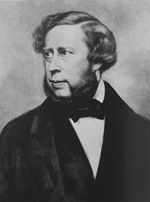Julius Schoppe

Julius Schoppe (born January 27, 1795 in Berlin ; † March 30, 1868 ibid) was a German portrait, landscape, decoration and history painter. He was one of the best portraitists of the Biedermeier period and the decades after. From today's perspective, his work in this field is one of the lasting achievements.
Career
Julius Schoppe came from a family of goldsmiths in Berlin and was related to the sculptor Gottfried Schadow . From 1810 to 1817 he went to the Berlin Academy ; his teacher was Samuel Rösel . A stay in Vienna in 1815/16 was followed in 1817 by a hike through Austria and Switzerland to Rome. The drawings he made on this trip were published as lithographs in 1823/25 . During the years in Rome from 1817 to 1822, Schoppe lived in the artist hostel Casa Buti on a scholarship from the Berlin Academy. During this time he copied painters of the Italian Renaissance , including works by Raphael , Titian and Correggio . Seven of his Raphael copies alone came into the Raffael collection of Friedrich Wilhelm IV. In the orangery of Sanssouci .
After returning to Berlin, Schoppe became a member of the Academy in 1825 and a professor in 1836. Hardly any works have survived from his early days, at the same time the painting of St. Elisabeth, handing out alms to the poor, from 1840 shows that Schoppe also dealt with other genres of painting in the early years. Otherwise he developed primarily as a portrait painter in Berlin; His numerous sensitive portraits of children are outstanding. He also participated in the interior painting based on designs by Karl Friedrich Schinkel , including the Crown Princess Elisabeth's tea room in the Berlin City Palace , the vestibule of the “New Pavilion” next to Charlottenburg Palace and the “Little Curiosity” tea room in the pleasure area of Glienicke Palace .
Works
- 1817 Phidias, who creates the ideal of Jupiter and odalisks in the bathroom (both lost)
- 1823/25 Picturesque views from the journey through Austria, Styria, Tyrol, Switzerland and Italy (lithographs)
- around 1825 evening party in a house on Dönhoffplatz
- 1827 Tree pulpit on the banks of the Havel by Glienicke
- 1831 Malwine von Bismarck, sister of the Chancellor
- 1836 Heinrich Jakob Schoppe (an uncle of the artist)
- 1836 Gustav Freiherr von Maltzahn Graf von Plessen on Ivenack , oil painting
- 1836 Cecilie Freifrau von Maltzahn Countess von Plessen , b. of smoke , oil painting
- around 1837 Princess Augusta of Prussia
- around 1837 Crown Prince Friedrich Wilhelm of Prussia
- 1838/39 various paintings by Princess Marie Luise of Sachsen-Weimar-Eisenach (wife of Prince Carl of Prussia ). Princess Marie of Prussia in a romantic garden landscape and Princess Marie of Prussia on horseback , Glienicke Palace, Berlin
- 1839 The sisters Blanka and Elise von Rauch , oil painting
- around 1840 St. Elisabeth, donating alms
- 1840 depictions of the Picture Hall of Patriotic History
- 1842 The last moments of King Friedrich Wilhelm III. then mezzotint by Sixdeniers, Alexandre Vincent (1793–1846 Paris), Le Blanc 10
- around 1842 Queen Elisabeth of Prussia
- around 1842 Princess Luise Marie Elisabeth of Prussia
- around 1845 Agnes von Scharnhorst
- 1859 Wilhelm Ferdinand Ermeler
Murals:
- 1825 Participation in the painting of the New Pavilion next to Charlottenburg Palace, Berlin based on designs by Karl Friedrich Schinkel (destroyed, partially restored in copy)
- 1825 wall medallions Perseus and Andromeda , bacchante on a tied centaur , Hylas drawn down into her source by nymphs , amphitrite and female centaur with youth in the tea room of the Berlin Palace, (destroyed) ''
- 1826/28 paintings based on models by Karl Friedrich Schinkel in the Palais of Prince Carl, on Wilhelmplatz in Berlin
- Around 1827 the tea room in the Little Curiosity of Glienicke Palace was painted in the style of Pompeian wall paintings based on designs by Karl Friedrich Schinkel.
- 1827 mural Pegasus washed and soaked by nymphs , originally in the corner of the west wing main building on the garden courtyard of Glienicke Palace, (destroyed)
- around 1828 Chapel of the Kronprinzenpalais , Berlin
- 1844 ceiling painting in the opera Unter den Linden , Berlin
literature
- Irmgard Wirth: Berlin painting in the 19th century . Siedler, Berlin 1990, ISBN 3-572-10011-9 , p. 126
Web links
| personal data | |
|---|---|
| SURNAME | Schoppe, Julius |
| BRIEF DESCRIPTION | German portrait, landscape, decoration and history painter |
| DATE OF BIRTH | January 27, 1795 |
| PLACE OF BIRTH | Berlin |
| DATE OF DEATH | March 30, 1868 |
| Place of death | Berlin |

